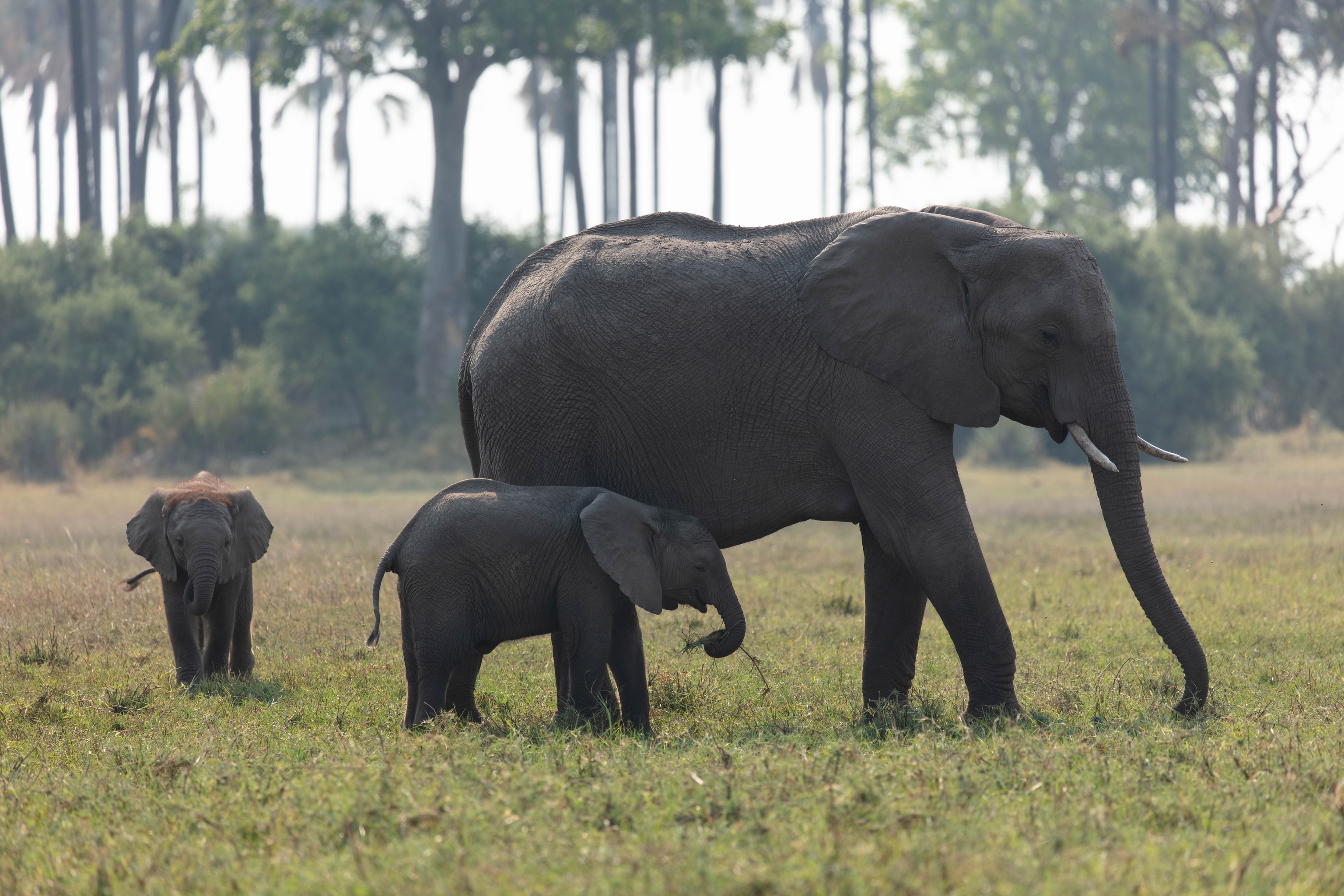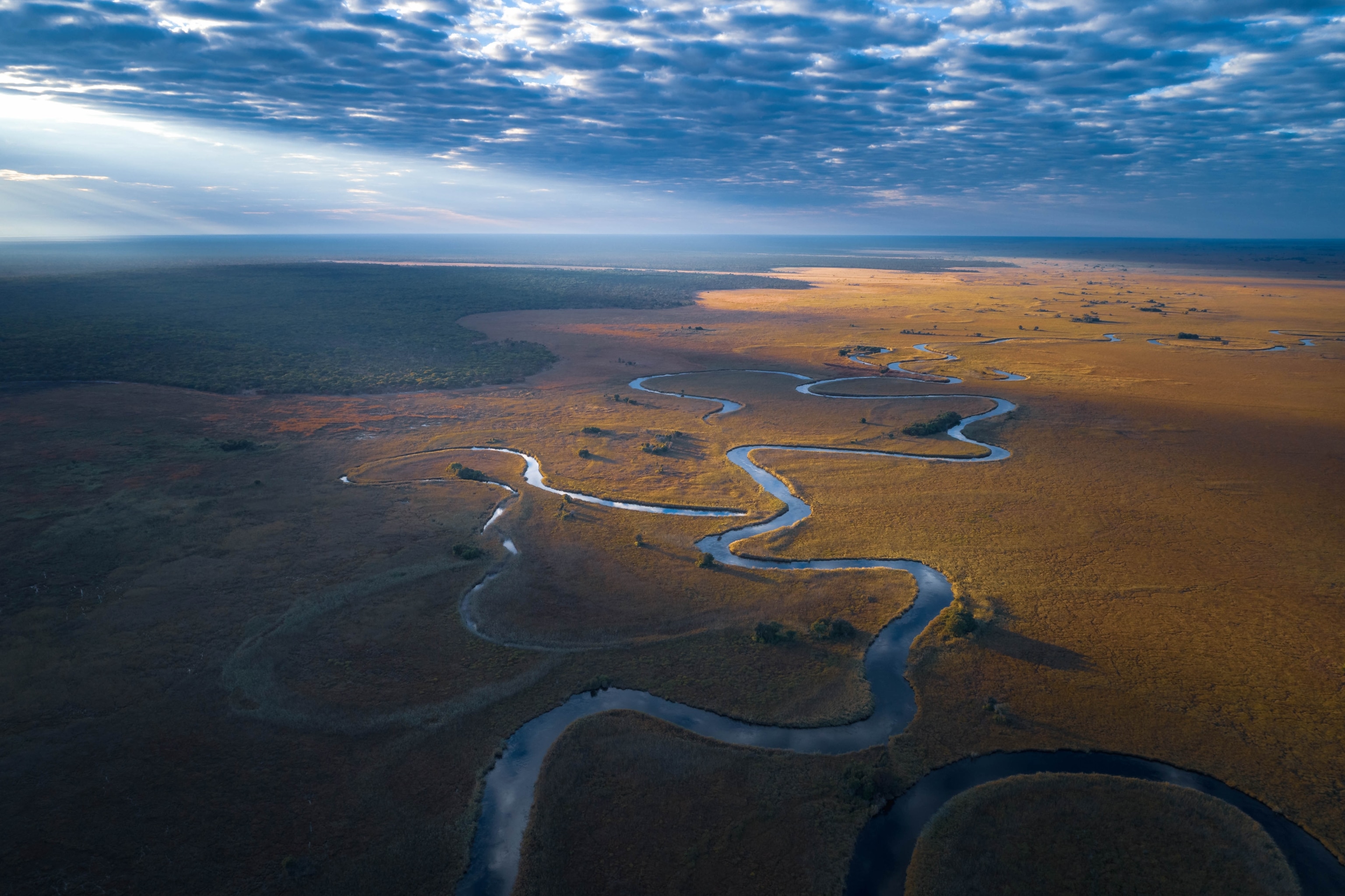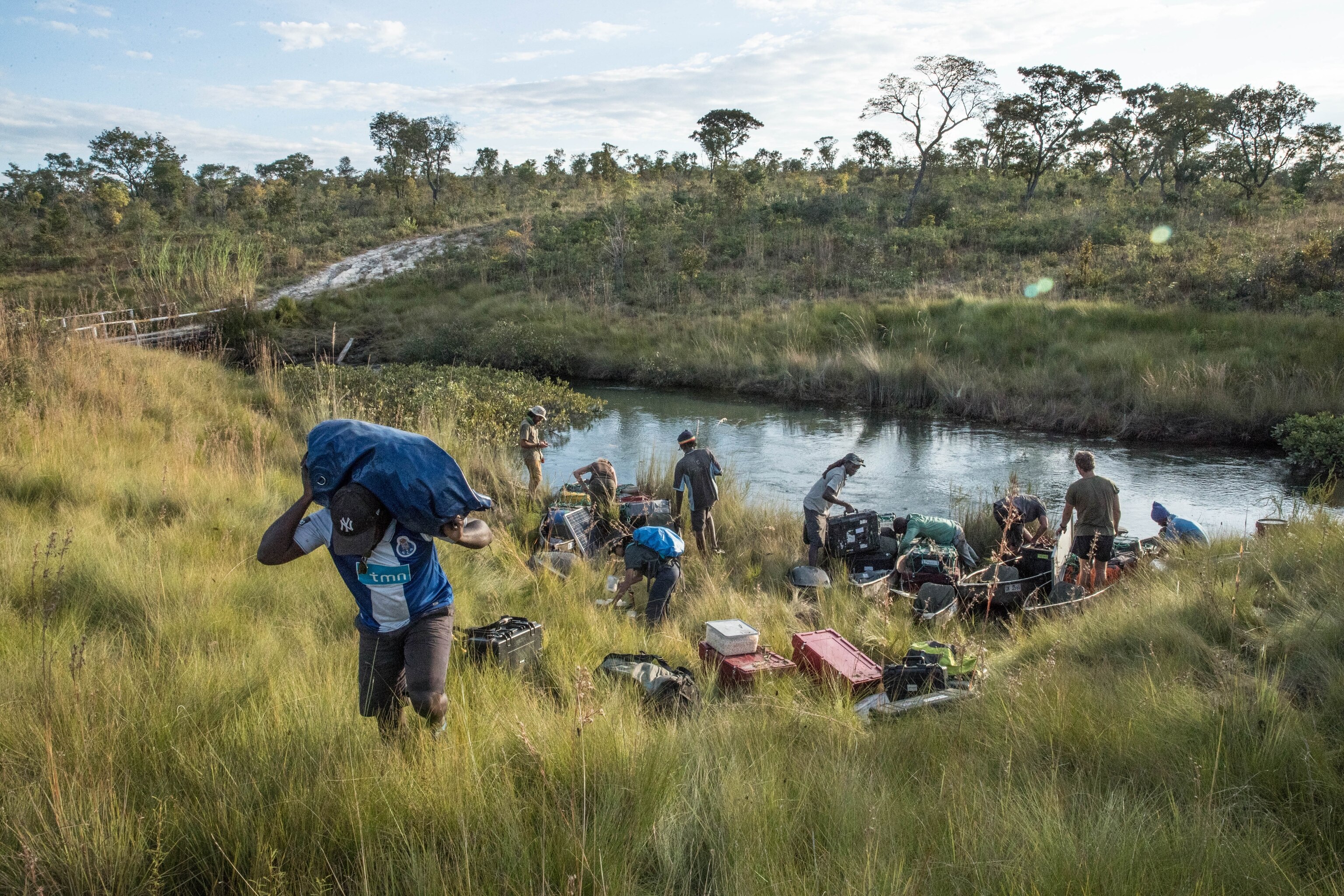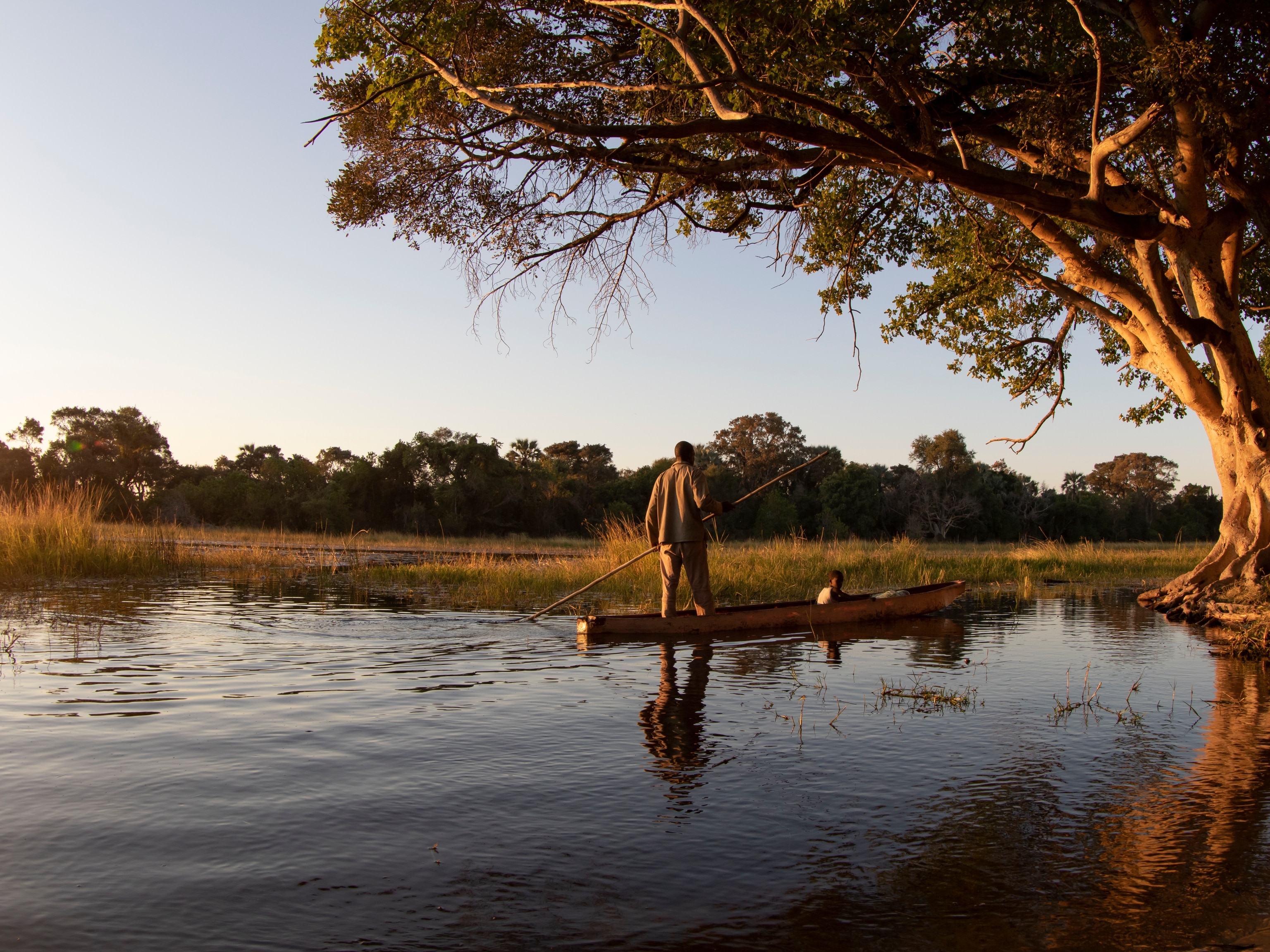Protecting the lifeline of the Okavango Delta
At the heart of northern Botswana’s Kalahari Desert lies one of Africa’s most remarkable natural treasures, but changing circumstances are putting its future at risk.
Viewed from low orbit above the African continent, the Okavango Delta shows up as a bright bluish-green alluvial fan carved into northern Botswana. For thousands of kilometers, watery fingers reach across the Okavango Basin before disappearing into Kalahari sands—a glittering hand gripping one of Africa’s driest regions, bringing with it a liquid gift that sustains a wilderness largely unscathed by destructive development.
As one of very few inland water deltas (the rivers that create it never reach the sea), the Okavango’s range of habitats, including marshes, channels, and deep lagoons, nourishes a sprawl of wildlife attracted from across southern Africa. Crocodiles, wild dogs, buffalo, zebra, and an abundance of birdlife share a wetland of at least 3,100 square kilometers (1,200 square miles) with populations of endangered large mammals like cheetah, lion, the white rhinoceros, and its even more endangered relative, the black rhinoceros. Botswana also supports the world’s largest population of elephants at around 130,000, making the Okavango Delta a core area for the species’ survival.

One of the most incredible phenomena of the Delta, known as the Jewel of the Kalahari, is the seasonal flooding that swells the grassy plains by nearly twice their original size, increasing the area of wetland from around 3,100 square kilometers (1,200 square miles) to around 7,700 square kilometers (3,000 square miles)—becoming the largest freshwater marsh ecosystem in the world. As seasonal floodwater spills in from the Okavango River it creates a myriad of different habitats that range from open floodplains, to islands that sprout riverine woodlands, forests, and open savannah, all turning the Okavango into a hive of animal activity.
What’s truly incredible, though, is how the wildlife here exists in perfect balance with the ebb and flow of water: one Okavango River deluge occurs at the height of Botswana’s dry season, revitalizing ecosystems and concentrating wildlife numbers until the floods begin to recede before the cycle begins all over again. It’s the most exceptional example of a delicate cause-and-effect balance between climatic, hydrological, and ecological processes you’re ever likely to see, and plenty of people are able to see it since the Delta supports a strong ecotourism industry responsible for bringing hundreds of millions of dollars into Botswana’s economy. Everything then, from life in the Delta to outside it, depends on the life-force, flood pulses of all that water.
That water does not come from Botswana. It comes from Angola’s highlands almost 1,000 kilometers (600 miles) and two political borders away. Angola’s summer rains fall into the country’s central highlands, where they’re soaked up by the spongey, peat-rich landscape. Water filters through grasses, peat deposits, and sand layers, attaining a purity that outrivals anything from a modern tap, before draining rapidly into the Cubango and more slowly into the Cuito, the two rivers responsible for delivering around 9.5 trillion liters (2.5 trillion gallons) of water to the Okavango Delta each year. At the southern Angolan border, the Cuito and Cubango merge to form the bigger Okavango River, which flows across a narrow band of Namibia called the Caprivi Strip and into Botswana. If this yearly lifeline somehow stops, then the Delta will no longer be able to exist as it is.

Shifts in Angola’s circumstances are making this a real possibility. Development, population density, water diversion, and upstream commercial agriculture are encroaching on land once uninhabitable due to the landmines left after civil war, now slowly but surely being cleared by the hard work of government, local communities, and non-profit organizations. If these remote places are not developed in a sustainable way, their ecosystems will disappear, no longer percolating the water that sustains the Okavango or the rest of the ecosystems that rely on it. But this eventuality hasn’t gone unnoticed―an international group of scientists, government officials, wildlife experts, journalists, photographers, NGOs, partners, and explorers are now working to stop it from happening.
Launched by National Geographic Explorer Dr. Steve Boyes and supported by the National Geographic Society, the effort that became the National Geographic Okavango Wilderness Project has been exploring the farthest reaches of the Delta, the Angolan highlands, and expanses of wilderness in between—areas that combine to form the Okavango Basin. These expeditions gather valuable data on wildlife numbers, new species, and how their interactions within their ecosystems affect the quality of Angola’s water. The end goal is to ensure that the conservation economy enjoyed by the Okavango Delta and Botswana extends right back up into Angola. If communities in and around Angola can benefit from sustainable development and tourism dollars generated by the Okavango’s “nowhere-else-on-earth” natural spectacle, then there will be more of an incentive to preserve lands as they are.
De Beers has joined National Geographic in a partnership called Okavango Eternal to help secure long-term protection for the near-pristine source waters of the Okavango Delta. Through their own Building Forever initiative, De Beers is committed to creating positive impacts for the people and countries where their diamonds are discovered.

Over the next few years, De Beers and National Geographic will work alongside local communities and governments to help build livelihood initiatives based on conservation and ecotourism for those living around the Delta—as well as those living up into Namibia and Angola. Part of this conservation effort will include the protection of wildlife corridors so that animals are able to move freely across borders; with more space to roam, dangerous encounters with humans will be minimized. And, to raise support, awareness, and encourage ecotourism, the partnership will bring the Okavango to the world through powerful storytelling that follows the work as it unfolds.
This is just the beginning of the partnership between De Beers and National Geographic, but it marks another leap forward in supporting a thriving future for one of Africa’s—and the world’s—most remarkable natural wonders.
Find out how De Beers creates positive impacts here.



